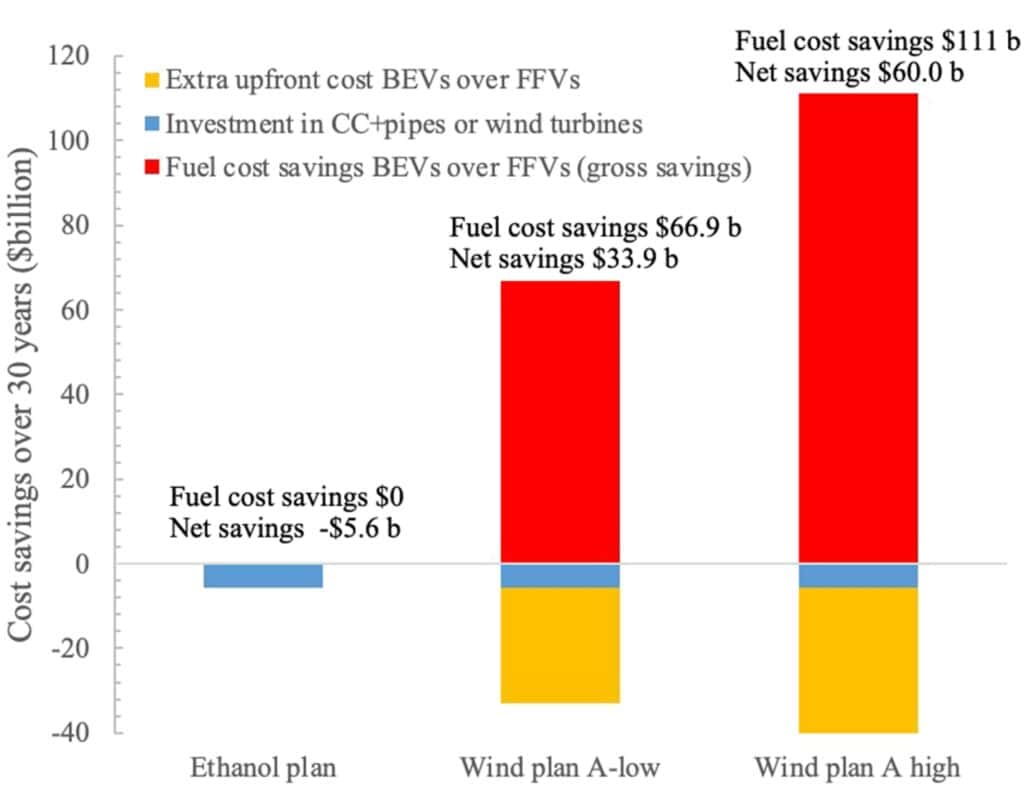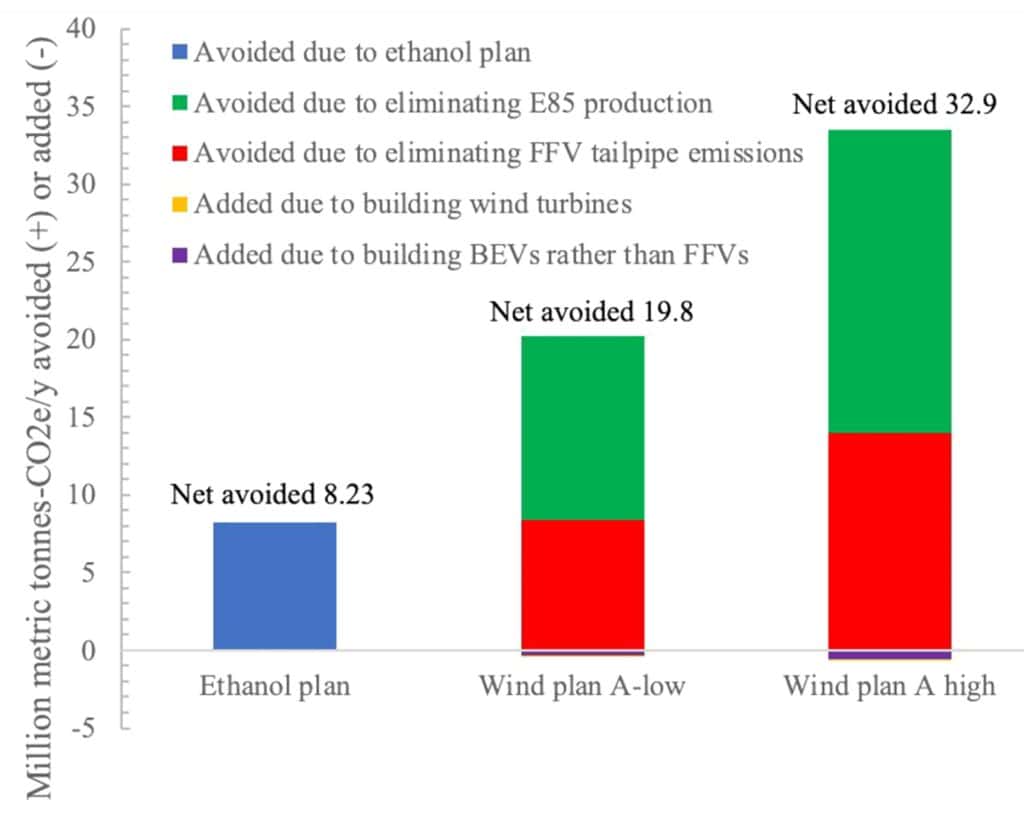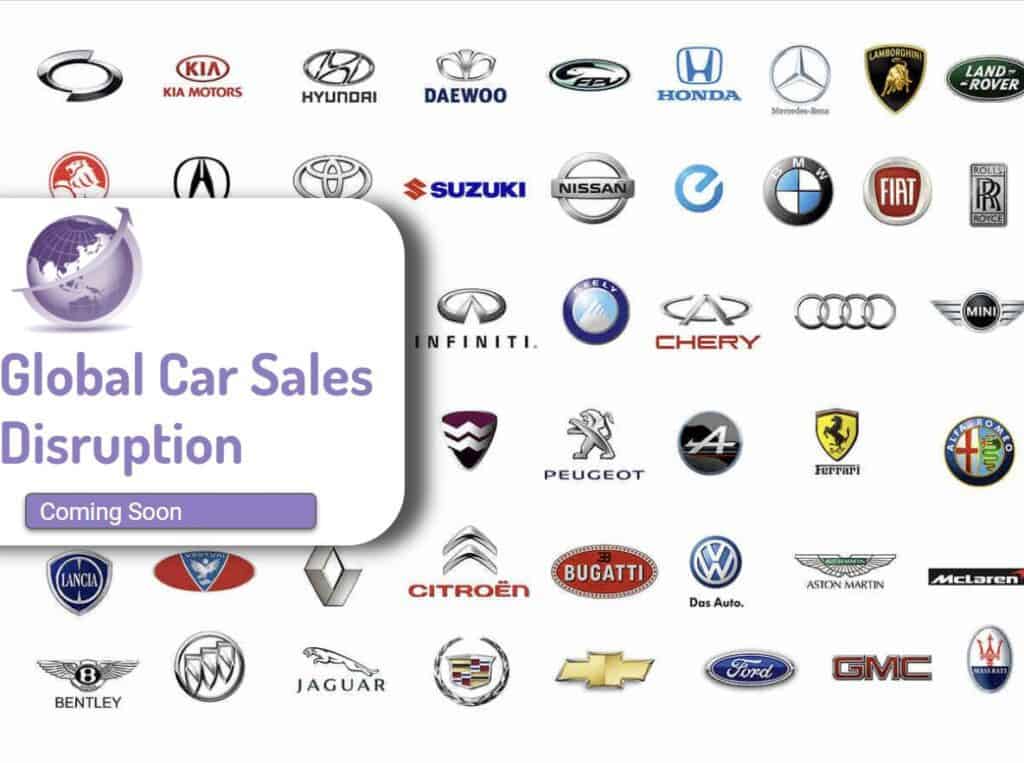E10 or Exx as an ethanol gasoline (petrol) mix for internal combustion engines (ICE) cars is widely used in many countries, but a proposal in the USA to use carbon capture for ethanol from corn has to be the most stupid of emissions reduction initiatives for a long time!
Prof Mark Jacobson explores this in Environmental Science and Technology in a case study with 5 USA state looking to capture carbon from the fermentation process of corn to ethanol.

Previously, we’ve shown ethanol is worse than gasoline, and it is ludicrous that farmland is used to grow corn, ferment into ethanol and then burnt in ICE vehicles. Not content with that, there is a $5.6 billion proposal to capture CO2 produced by the yeast in fermentation, pipe it 2,000 km and then “bury” it in the Dakota badlands. Or potentially use it to extract more gas and oil from older fields.
Background to Ethanol for Vehicles and Carbon Capture
USA and Brazil farmers are the largest group to grow corn to go to ethanol fermentation plants to convert into ethanol. CO2 is produced and would be easy to capture, compress and ship in pipelines.
Three companies propose to add carbon capture equipment to the fermentation process during ethanol production and build pipelines under the properties of hundreds to thousands of landowners across multiple states to transfer the CO2 to an underground storage facility.
- Navigator is proposing ∼1300-mile pipeline
- Wolf, ∼380-mile pipeline
- Summit ∼3600 km pipeline, with 34 ethanol plants at $5.6b cost. The CO2 captured would be 9.5mt
In theory, capturing CO2 from the fermentation process during ethanol production may reduce ethanol’s overall lifecycle CO2 emissions by∼30g-CO2e/MJ,
Battery EVs Emit Much Less Than ICE Cars
EV production emits more CO2 due to battery production. Currently, that’s about 75 kg CO2 per kWh of battery. So for an average 68 kWh battery that’s about 5t of CO2 more during production.
However, because combustion engines waste over 75% of energy as noise and heat (while the EV wastes about 15%) the picture changes quickly once you start driving.
An ICE car in the UK emits around 200 g/km less CO2. After 25,000 km CO2 from the battery production is negated. This is for the average UK grid mix over the lifetime of the car. (The method is called a full life cycle analysis or LCA.) As the grid gets cleaner the payback time becomes shorter.
That means a current combustion car emits 3x more CO2 over its lifetime. In 2030 it will be 5x more and in 2050 10x more. (Auke Hoekstra – Joule). Moreover, batteries already outlast the car and the best estimate is second life or recycling after 250,000 km
Carbon Capture for Ethanol Is Ludicrous
Jacobson used a complex model and compared building the ethanol and CCS plant versus building wind farms needed for the energy from the ethanol
- Production of E85 from ethanol with carbon capture, followed by E85’s use in a 2023 Ford F-150 four-wheel drive (4WD), 8-cylinder ICE pickup
- Production of wind electricity, followed by its use in a 2023 Ford -150 Lightning 4WD extended range BEV
The model also assessed 2 wind scenarios. Scenario A that the 5 states, which are currently burning coal. States were Iowa, Nebraska, SouthDakota, Minnesota, and North Dakota. Scenario B was if these states went all wind.
Costs and Returns
The economics do not stack up. There is at least a 12−20 times better return to have wind and electric trucks than the $ 5.6 billion investment in Summit project.
- Fuel savings was $66.9−$111billion (USD 2023) over 30 years for the BEV
- Higher upfront costs with BEV than with ICE vehicles
- Cost of deploying wind – enough for the vehicles or for all of the states.

Emissions
Like economics, emissions from wind are 25% to 60% less than from the fermentation/carbon capture proposal. Furthermore emissions from burning the ethanol in the vehicle continue to pollute the environment, causing asthma and respiratory illnesses.

Figure2. Million metric tonnes per year of avoided CO2e due to the ethanol plan versus wind plan A. The net value in the ethanol plan includes CO2e removed by carbon capture plus the CO2e added back to the air due to electricity needed for CO2 compression and due to building the pipeline
References
- Should Transportation Be Transitioned to Ethanol with Carbon Capture and Pipelines or Electricity? A Case Study by Mark Z. Jacobson Environmental Science & Technology 2023 57 (44), 16843-16850 DOI: 10.1021/acs.est.3c05054 or download from https://web.stanford.edu/group/efmh/jacobson/Articles/Others/23-E85vBEVs.pdf
- The Underestimated Potential of Battery Electric Vehicles to Reduce Emissions 2019 Prof Auke Hoekstra, Department of Mechanical Engineering, Eindhoven University of Technology, 5612 AZ Eindhoven, the Netherlands. Joule https://doi.org/10.1016/j.joule.2019.06.002









